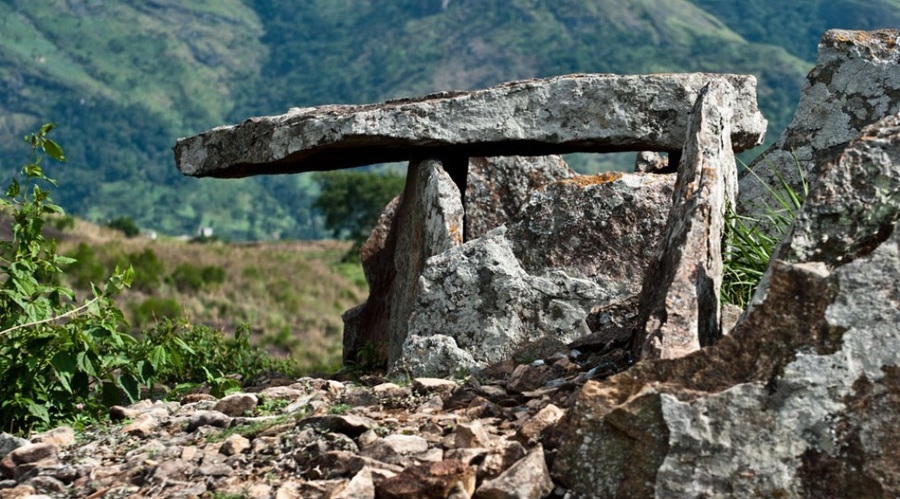

Muniyara Dolmens
Natural Sandalwood Forests and Sugarcane Farms, whose molasses draw people in from across the world, are not really regular day-to-day sights anywhere in the world. This, however, is the case with Marayoor; a green hamlet located about 40 km from Munnar. Annually, people come here to immerse themselves in its exceptional sights that cannot be found anywhere else in Kerala. The beautiful Pambar River flows between the villages of Marayoor and Kanthalloor, and has a calming influence on all who visit its shores.
Muniyara, a prehistoric site inside the Marayoor Forest Range is where one sees scores of historians and anthropologists congregate. The 2000-year-old megalithic monuments, which were ancient burial grounds, have been researched for centuries. Also lying inside the forest range is the mysterious Ezhuthupara, where cave paintings not seen anywhere else across the State, have confounded all who view it. You can also go to the 'Sandalwood Regeneration Experimental Plot' and learn about this unique forest and the around 65,000 trees that reside here. You can take a leisurely stroll and learn about how sandalwood is processed. A visit here is not complete without tasting the special molasses or 'Marayoor sarkara'. Its 97 per cent sugar content makes it the highest quality product available in the State.
Where is Muniyara Dolmens?
The Muniyara Dolmens are magnificent prehistoric dolmens, situated in Marayoor, approximately 55kms from Munnar. Belongs to the Neolithic Age, these aboveground burial chambers are built with large stone slabs and are called 'megaliths.
What is the use of Muniyara?
Muniyaras are ancient burial vaults, which throw light on the ancient practices and lifestyle. They are also archaeologists' and historians' delight. Archaeologists conducted many excavations at various points around the foot of the Ambukuthi Hill in Wayanad district.
What is the history of dolmens?
Dolmens are ancient megalithic structures, typically single-chamber tombs, dating back to the early Neolithic period (around 4000-3000 BCE). They consist of two or more upright stones supporting a flat capstone, and are found across various regions including Europe, Asia, and North Africa.
What is the history of Marayoor?
Marayoor in Munnar, Kerala, India, boasts a rich history dating back to the Stone Age and beyond. It is home to ancient dolmens (burial chambers), rock paintings, and remnants of a Stone Age civilization. The name Marayoor, meaning "village of Maravars," suggests the presence of a tribe that lived in the area during the turn of the Christian era.
Who was buried in dolmens?
Many dolmens are also associated with graves of famous giants or warriors, such as Nuada of the Silver Arm in Sligo's Labby rock
Which country has the most dolmens?
The largest concentration of dolmens in the world is found on the Korean Peninsula. With an estimated 35,000 dolmens, Korea alone accounts for nearly 40% of the world's total.
How old is dolmen?
The earliest dolmens date back to the Neolithic period, spanning from 4500 to 2000 BC.
Where are dolmens found in India?
Southern India - South India particularly the states of Karnataka, Tamil Nadu, Kerala, and Andhra Pradesh, has a significant concentration of dolmen sites.
What is the meaning of Muniyara?
The name 'Muniyara' is derived from the Malayalam words 'Muni' (sage) and 'Ara' (shelter), referring to the ancient dolmens or burial chambers found in the region.
What is the shape of dolmens?
A rectangular dolmen (German: Rechteckdolmen), extended dolmen (German: erweiteter Dolmen) or enlarged dolmen is a specific type of megalith, rectangular in shape, with upright side stones and, usually, two capstones.
Is dolmen a megalith?
A dolmen is a prehistoric megalithic building with one many big covering slabs (tables) lying on standing stones which are its legs (the orthostasts).
What is a dolmen stone?
A prehistoric monument of two or more upright stones supporting a horizontal stone slab found especially in Britain and France and thought to be a tomb.
Who built dolmens?
The dolmen was built by Neolithic farmers, who chose the location either for ritual, as a territorial marker, or as a collective burial site. What remains today is only the "stone skeleton" of the original monument; originally, it would have been covered with soil, and its flagstone capped by a cairn.
How do dolmens work?
A dolmen, or portal tomb, is a type of single-chamber megalithic tomb, usually consisting of two or more upright megaliths supporting a large flat horizontal capstone or "table".
What is dolmen made off?
A dolmen is a burial chamber built with vertical stones and horizontal stones, the whole resembling a stone table. In the Neolithic period, the deceased were buried inside. There are many different types of dolmens: simple or with corridors, sometimes with several chambers.
Facilities available:
Publish your photos here to send us info@munnarinfo.in


